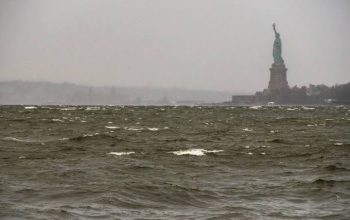As Hurricane Milton barrels towards Florida, officials are warning residents about the devastating threat of a storm surge, a dangerous and potentially deadly component of the massive weather system. With Florida’s coastal areas in the storm’s direct path, the impact could be catastrophic, making evacuation and preparedness more crucial than ever.
What Is a Storm Surge?
A storm surge is the abnormal rise of water generated by a storm’s winds, pushing ocean water toward the shore. This surge can raise sea levels by several feet, depending on the storm’s intensity and coastal geography, and can result in extreme flooding that extends miles inland. It is often the most dangerous aspect of a hurricane, leading to widespread destruction and significant loss of life.
In the case of Hurricane Milton, experts predict a particularly high storm surge due to its Category 4 status, with wind speeds exceeding 130 mph. These intense winds will drive large volumes of water onto the coast, threatening homes, businesses, and critical infrastructure in low-lying areas. The National Hurricane Center (NHC) has issued a warning, calling the expected surge “life-threatening.”
Why Is Milton’s Storm Surge So Dangerous?
Storm surges have the potential to cause more damage than the hurricane’s winds or rainfall. As Hurricane Milton approaches Florida, meteorologists are estimating that the storm surge could reach up to 10 feet in some areas. This wall of water can wipe out entire neighborhoods, flood roads, and make rescue efforts nearly impossible.
Low-lying areas along Florida’s Gulf Coast are especially vulnerable. In these regions, the combination of high tides and the storm’s powerful winds pushing water inland could lead to unprecedented flooding. Cities such as Tampa, Fort Myers, and Naples are on high alert, with local authorities urging residents to evacuate immediately if they are in surge-prone areas.
The storm surge from Hurricane Milton will also be exacerbated by Florida’s flat coastal landscape, which allows water to spread quickly and flood vast areas. Even regions that are miles from the shoreline could face severe flooding, causing a widespread humanitarian and infrastructure crisis.
The Effects of Storm Surges
The impact of a storm surge can be disastrous. Homes and buildings near the shore can be completely destroyed by the powerful floodwaters, while streets and highways turn into rivers, making travel impossible. Power outages are expected to occur as electrical systems are compromised by the floodwaters. Additionally, the storm surge could contaminate drinking water supplies with saltwater, creating further health hazards.
In previous hurricanes, storm surges have proven deadly. For example, Hurricane Katrina in 2005 caused a massive storm surge that overwhelmed levees and resulted in catastrophic flooding in New Orleans. Similarly, Hurricane Harvey’s surge in 2017 brought devastating floods to Houston, displacing thousands of people.
Evacuation and Safety Measures
As Hurricane Milton approaches, Florida’s state and local governments have already initiated evacuation orders for the most vulnerable areas. Shelters are being opened across the state, and emergency services are on high alert to respond to the disaster.
Residents in coastal and low-lying regions are being urged to take immediate action. Those who have not evacuated should secure their homes, move to higher ground, and avoid attempting to drive through flooded areas. Emergency kits, containing essentials like water, food, and medical supplies, should be prepared in case of power outages or the need to evacuate.
Authorities stress that the most important thing people can do is follow evacuation orders. Once the storm surge hits, it may be too late to leave, and those who remain in surge zones could find themselves trapped by rapidly rising waters.
Conclusion
As Hurricane Milton hurtles towards Florida, the threat of a deadly storm surge is becoming more real by the hour. With the potential to cause widespread flooding, destroy homes, and put lives at risk, this weather phenomenon is not to be underestimated. Residents must heed official warnings and evacuate immediately if they are in vulnerable areas. With preparation and caution, the worst effects of this dangerous storm can be mitigated.



